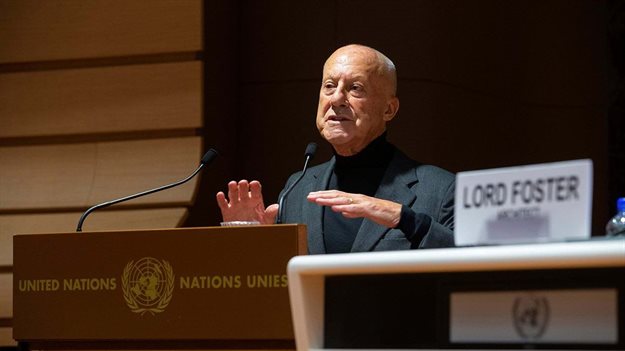Covid-19 will not change cities in long term - Norman Foster

"Is Covid-19 going to change our cities? I suggest that it might seem so now, but in the wider arc of history, the answer is no," he said. "Instead of change, it has merely hastened, accelerated trends of change that were already apparent before the pandemic."
"The only constant is change and cities are forever evolving, learning from each other across continents. Changed by the technologies of their times and by leaders who have the vision to embrace them," Foster added.
Impacts of previous crises
Foster outlined the impacts of previous crises that cities have had and drew attention to their impacts.
"Take London as an example. The Great Fire, 1666, created building codes that led to fireproof brick construction."
"The Cholera epidemic of the mid nineteenth century cleaned up the Thames from an open sewer and was the birth of modern sanitisation. In its wake came the healthy dimension of public parks. Then Tuberculosis struck and helped the birth of the modern movement in architecture – big windows, sunlight, terraces, white and clean."
"But every one of those consequences – fireproof construction, sewers, green parks, modernism – would have happened anyway and not just in London, but in cities around the world because cities learn from each other – each crisis hastened and magnified the inevitable," he continued.
"It has been said if you want to look far ahead, then first look far back. History tells us that the future is not two-metre distancing. The last major pandemic, 1918-20, claimed more lives and young ones, created deserted city centres, face masks, lockdowns and quarantines. Sounds familiar? It also heralded the social and cultural revolution of the 1920s with big public gathering spaces, department stores, cinemas and stadia."
Sustainable buildings could become mainstream
According to Foster, mobility, sustainable buildings, green spaces, monorails could be the mainstream of our coming age.
"What, after this pandemic, will the equivalents be for our coming age? What defines us? It’s mobility. Mobility of people, goods and information at a time of climate change and decarbonisation," Foster explained.
"We now have scientific evidence to prove that green buildings with natural ventilation are not only good for your health, but they enable you to perform better. These kinds of buildings are now the exception."
"But they could become mainstream. We also have proof that green spaces in cities – however big or small – contribute to health and wellbeing. I have worked with civic leaders over several decades in the German Duisburg to bring green and progression to what could have been a rust belt," he added.
"The cumulative effect of just some of these many trends are transforming city centres and local neighbourhoods, making them quieter, cleaner, safer, healthier, more friendly, walkable, bikeable and, if the opportunity is grasped, to be greener."
"As less space is needed for transport, we could see increased paved public space, avenues of trees, mini parks, new terraces using radiant technology to be cooler in summer, warmer in winter. Trees beautifying as well as absorbing Co2 to improve the air quality."
Covid-19 has accelerated more sustainable, equitable trends
"This is what I mean when I say that Covid-19 has accelerated more sustainable and equitable trends. Many of you at this event have embraced change with enthusiasm and, through leadership, have brought your citizens with you – setting new standards for all," Foster explained.
"Neighbourhoods have seen a resurgence in appeal with the tag of the “15-minute city” – where living, working, dining, learning, being entertained and entertaining can all happen within walking distance. This is not new, but it has been boosted by the pandemic, and by design could be improved."
"Some dense communities have not seen higher infection rates than the suburbs. The problem is dense cramped households, which could be within cities or suburbs alike – already an issue before the pandemic. Affordable housing remains a challenge and is linked to the homeless issue."
"Some of these trends are not new. I led the changes that transformed Trafalgar Square in the heart of London, and rescued the Port of Marseilles from traffic to bring it back to a neighbourhood."
"I witnessed in America Boston’s big dig, in Europe Madrid’s Rio Project and in Asia Seoul’s city centre – all have created vast new green parks out of highways from the past," Foster continued.
"In the move to making cities self-sustaining, barriers between different interest groups and professions need to be relaxed in a holistic approach. An obvious example is when those concerned with waste work with the energy sector to convert waste to energy – but there are many other examples of such synergies."
"The pandemic is a tragic event for so many, we have all lost loved ones and for the moment, the virus continues. But stepping back, I am confident that cities will prove their resilience and appeal - they will bounce back stronger and better as a consequence."
"We are all of us grateful for the untiring efforts and leadership that you, the mayors and civic leaders, are achieving in these difficult times and looking beyond into a bright future," Foster concluded.
Article originally published on World Architecture Community.
Source: World Architecture Community

Since 2006, World Architecture Community provides a unique environment for architects, architecture students and academics around the globe to meet, share and compete.
Go to: https://worldarchitecture.org/



